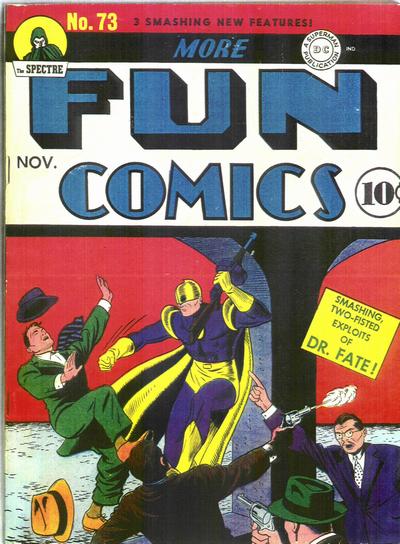Welcome to another edition of Those Who Came Before, where we look back at the creative people that helped forge this medium which we love. This time we’re looking at Mort Weisinger, an artist from the Golden Age who had his hand in the creation of some of our greatest heroes.
Personal Life
Born in New York City in 1915, Weisinger was yet another Jewish resident of the city who would later go on to a career in comics. Yes, in case you haven’t been paying attention, plenty of the biggest names in comics were born and raised in NYC. There was Stan Lee, Kirby, Eisner, Kane, Finger, and George Pérez, among many others. Raised in the Bronx, Weisinger attended New York University after high school. While there, he spent time as the editor of the school’s newspaper.
In September of 1943 Mort Weisinger and Thelma Rudnick were married, and they went on to have two children, Joyce and Hendrie. He and Thelma were still married when Weisinger died in May of 1976. It’s always nice to see people stay together for so long.
Sign of things to come?
Around 13 years of age he got his hands on the August 1928 issue of Amazing Stories, featuring a Buck Rogers story, and his love of science fiction began. Within two years he was actively involved in clubs and fanzines, such as The Planet. In 1931 he met Julius Schwartz at a meeting of the science fiction fan club, The Scienceers. Out of this fan club grew one of the first science fiction fanzines, The Time Traveller. It was started by Weisinger (Associate Editor), Schwartz (Managing Editor), Allen Glasser (Editor), and Forrest J. Ackerman (Contributing Editor). Weisinger was about 17 years old at the time, with the rest of them being rather young men as well. The Time Traveller is known as the first fanzine to be devoted exclusively to science fiction, and it ran for almost 5 years, until January of 1937. During that time it published interviews and short pieces by some of the leading science fiction writers of the day. Certainly a good start to a career in comics.
Sci-Fi Agent
Before he got into comics, there was more business for young Mr. Weisinger. In 1934, he and Schwartz founded Solar Sales Service, a literary agency that went on to represent several prolific writers. They specialized in science fiction, fantasy, and horror, and were pioneers in this area. Among their first clients were Edmond Hamilton (author of what’s considered to be the first hardcover compilation of science fiction, The Horror on The Asteroid and Other Tales of Planetary Horror) and Otto Binder (a huge contributor to the Captain Marvel mythos). They went on to represent such prominent writers as H. P. Lovecraft, Stanley Weinbaum, John Russell Fearn, Alfred Bester, and Ray Bradbury.
Although Solar Sales Service would last until 1944, Weisinger left not too long after its formation. He ended up with the Standard Magazine chain, publisher of pulp magazines. As editor of Thrilling Wonder Stories, he bought stories from several writers, including clients of his former partner at Solar Sales. Weisinger was a very busy man, editing several publications for Standard, including Startling Stories and Captain Future. On a side note, am I the only one who gets a kick out of these names? Captain Future (both the title and a character) has got to be one of the coolest I’ve come across. By 1940, he was apparently editing around 40 titles. That’s quite a workload.
Comics
In 1941, he went to work for National Periodicals (later became DC Comics), editing Superman and Batman titles. He was also tasked with coming up with new characters, which he did in New Fun #73. He co-created Green Arrow, Aquaman, Speedy (Roy Harper), and Johnny Quick in that issue. Talk about a huge impact from just one little comic book! Now whenever I read The Longbow Hunters, one of my favorite Green Arrow stories, I’ll think of a guy named Mort.
Weisinger didn’t have time to sit around and enjoy his new career, as life was interrupted by his military service in World War II. He served as a sergeant in Special Services, stationed at Yale, and rooming with actors Broderick Crawford and William Holden. One if his jobs was writing scripts for the U.S. Army radio show I Sustain the Wings. His military career ended with his discharge in 1946, at which time he returned to National.
Superman
After his return from the war, Weisinger went back to his editor position with several titles for National, including once again Superman titles, Batman, and others. During his time as editor, Weisinger contributed much to the story and myth of Superman. There were many new ideas introduced into Superman’s life during this period. Some of these were Supergirl, the Phantom Zone, Krypto, Kandor, Brainiac, the Legion of Super-Heroes, the different types of Kryptonite, the idea of Superman’s powers coming from a yellow sun, and more.
There were other ideas that were implemented with success. Real life personalities were introduced into the stories from time to time, such as Steve Allen, and Pat Boone. Non-canonical, out of continuity, stories began appearing, which would have been impossible to pull off under normal circumstances. Such as Superman having the head of a lion. He had stories featuring a powerless Superman having to use his intellect to overcome his foes.
Weisinger has claimed that many of his ideas came as a result of asking kids in his neighborhood what they wanted to see for Superman, and expanding on their ideas. He even bought a story from, and hired, then 14-year-old Jim Shooter. Weisinger made it a practice to provide writers with plot ideas from which to work, thus explaining how an editor had so much influence on the content of the stories.
Weisinger even spent some time in the early 50s as a story editor for the Superman live action TV series, starring George Reeves.
I met George Reeves, the actor who played Superman and was one helluva nice guy — very, very unaffected. The amazing thing was that when you met Reeves you said, ‘My lord, it’s Clark Kent!’ It was like seeing Clark step out of the comic pages into three dimensions. —
Mort Weisinger
Clearly, this man had a huge impact on Superman’s character during the 50s and into the 60s. He was editor on Superman titles until 1970, being succeeded by his long time friend, Julius Schwartz. Weisinger was memorialized in Superman #273, with a bust of him appearing in Clark Kent’s apartment.
Other Works
Weisinger is credited with having written tons of articles, many after his retirement from DC. Some publications that published works of his include The Journal of the AMA, Reader’s Digest, Collier’s, The Saturday Evening Post, Parade, and Better Homes and Gardens. He’s got a best selling novel to his credit, The Contest, about the Miss America beauty pageant. One of his better known works is 1001 Valuable Things You Can Get For Free, originally published in 1955, which by 1975 had sold over three million copies.
Management Style
This is an area of his professional life that has gotten Weisinger some criticism, the way he managed others. Some have absolutely vilified the man as an overbearing, micro-manager. Trying to evaluate a man in this fashion, so many years later, is not something I feel can be done with any real rate of accuracy. Nor do I believe it’s fair to any of the parties involved to make the attempt. I will say that this criticism is something that has been addressed by Weisinger himself. One thing is clear: he had a big presence. There are plenty of articles that take a…different approach to describing Weisinger, however, I’m interested in what he did for comics, which was considerable.
Conclusions
It’s obvious to me that Mort Weisinger made a vast amount of valuable contributions to comics. With the characters he helped create, such as Green Arrow and Aquaman, he left a legacy that may outlive all of us. Then you look at what he did with Superman, and the man definitely deserves a place in the collective memory of those of us who love comics.
Eli Anthony
eli@comicattack.net









“Weisinger has claimed that many of his ideas came as a result of asking kids in his neighborhood what they wanted to see for Superman, and expanding on their ideas”.
Wow, imagine that. Sounds like some may paint him as a tough guy to work for but in the end it seems like his love for comics was what he really wanted to be remembered for…and should. Great article Eli, fantastic.
a great article Eli I’ve heard of Weisinger before but not much detail and now whenever I make an Aquaman crack I’ll think of a guy named Mort too.
Thanks guys, Mort was an interesting creator to research.
You know, there just aren’t enough guys around anymore named Mort.
Pingback: The Way the Future Blogs, an online memoir by science fiction writer Frederik Pohl » Blog Archive » Alfie
Pingback: The Jewish Culture Log of Arts » Blog Archive » The Jewish Side of NYCC on Sukkot
Pingback: The Way the Future Blogs, an online memoir by science fiction writer Frederik Pohl » Blog Archive » The Campbell Letters
Pingback: The Way the Future Blogs, an online memoir by science fiction writer Frederik Pohl » Blog Archive » Julie Schwartz
Pingback: Kurt Schaffenberger: The Definitive Lois Lane Artist of the Silver Age – In My Not So Humble Opinion